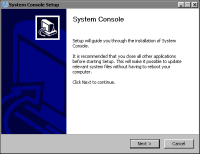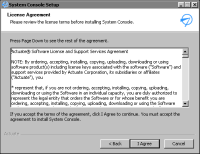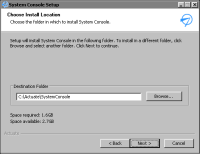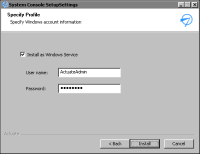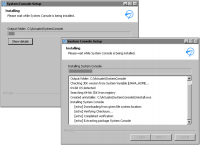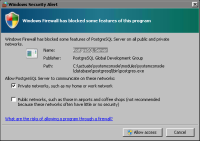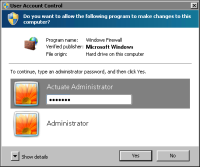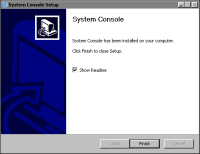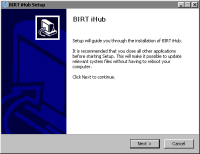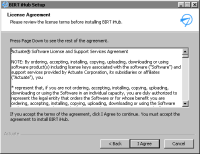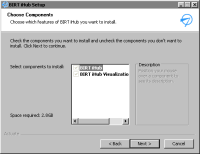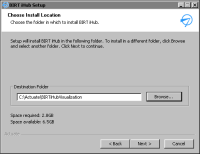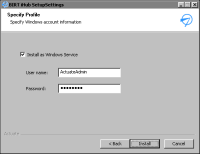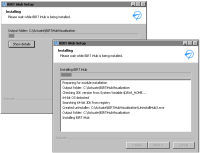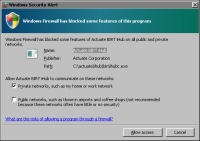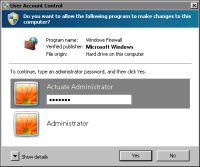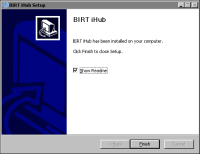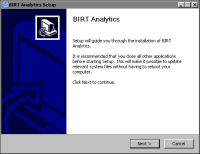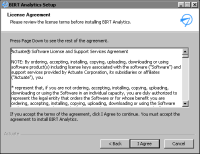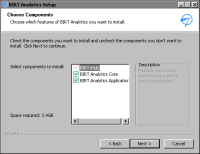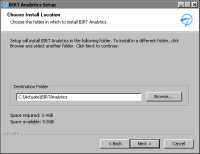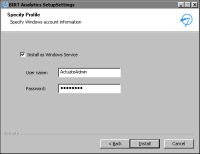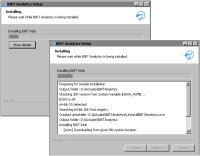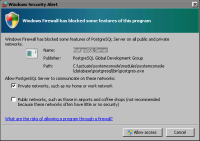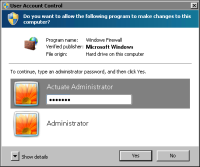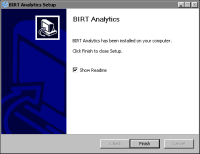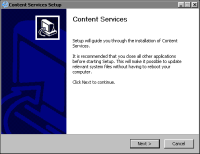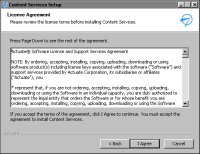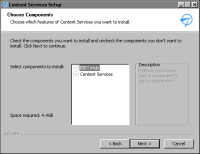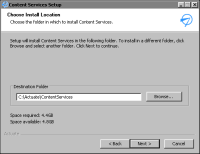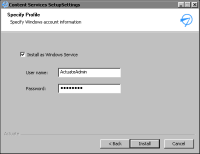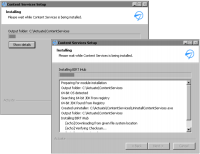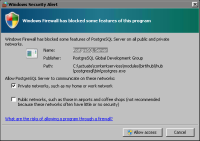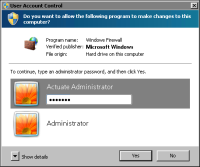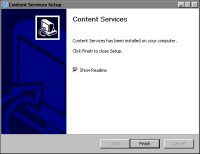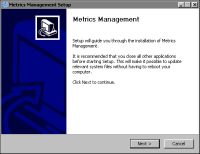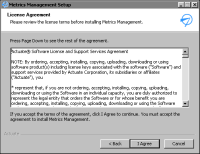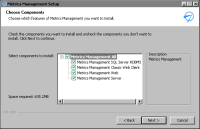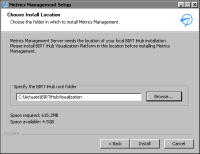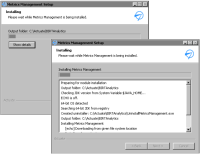Using the installation programs for Windows
When installing using the BIRT iHub installation programs, the administrator performs the following tasks:

Downloads the executable installation programs, SystemConsole-ihub3.exe and the installation program for another iHub module, such as BIRTiHubVisualization-ihub3.exe, from the software distribution site

Runs the System Console installation program, installing System Console into a directory such as C:\Actuate\iHub3, using the embedded evaluation license

Runs the installation program for another module, such as the BIRT iHub Visualization Platform installation program, installing the module into a directory such as C:\Actuate\iHub3, using the embedded evaluation license
How to run the System Console installation
For information about accessing System Console after installation, see
Setting up BIRT iHub and accessing modules.
1 Download the self-extracting executable file, SystemConsole-ihub3.exe, from the software distribution site.
2 Run SystemConsole-ihub3.exe. The Installer Language message appears. Select a language or accept the default language, English. Then, choose OK.
3 System Console Setup appears, as shown in
Figure 1‑1. Choose Next.
Figure 1‑1 Viewing System Console Setup
4 In License Agreement, choose I Agree, as shown in
Figure 1‑2. Choose Next.
Figure 1‑2 Agreeing to System Console license terms
5 In Choose Install Location, in Destination Folder, accept the default path or choose Browse to specify a new destination folder in which to install System Console, as shown in
Figure 1‑3. Choose Next.
Figure 1‑3 Choosing the System Console installation folder
6 In Specify Profile, specify the Windows account information, including user name and password, and select whether to install System Console as a Windows service, as shown in
Figure 1‑4. Choose Next.
Figure 1‑4 Specifying Windows account information for System Console
If you select installation as a Windows service, the installer checks whether the account specified has the Log on as a Service privilege. If the account does not have the privilege, a message appears. Choose OK. Perform the steps described in
How to configure the log on as a service privilege. Then, choose Install.
Installing appears, showing the status of the System Console installation process, as shown in
Figure 1‑5. Choose Show Details to see more information about the System Console installation operations.
Figure 1‑5 Viewing the System Console installation process
7 If a Windows Security Alert appears indicating that the firewall is blocking access to System Console or one of its related programs, perform the following tasks:
1 In Allow PostgreSQL Server to communicate on these networks, for example, select Private networks, such as my home or work network. Then, choose Allow access, as shown in
Figure 1‑6.
Figure 1‑6 Allowing firewall access to PostgreSQL Server
2 In User Account Control, type an Administrator account password, as shown in
Figure 1‑7.
Figure 1‑7 Entering an administrator account password
3 Repeat this step for other Windows Security Alerts, such as Java Platform SE binary, if prompted to do so.
8 With Show Readme selected, choose Finish to close System Console Setup, as shown in
Figure 1‑8. Alternatively, deselect Show Readme to not open the readme.txt file.
Figure 1‑8 Choosing Finish to close System Console Setup
With Show Readme selected, the readme.txt file opens in Notepad. This file states that BIRT iHub installed successfully and a shortcut to the product is on the Desktop and in Windows Start menu. A shortcut to System Console appears on the desktop.
How to run the BIRT iHub Visualization Platform installation program
For information about accessing BIRT iHub Visualization Platform after installation, see
Setting up BIRT iHub and accessing modules.
1 Download the self-extracting executable file, BIRTiHubVisualization-ihub3.exe, from the software distribution site.
2 Run BIRTiHubVisualization-ihub3.exe. The Installer Language message appears. Select a language or accept the default language, English. Then, choose OK.
3 BIRT iHub Setup appears, as shown in
Figure 1‑9. Choose Next.
Figure 1‑9 Viewing BIRT iHub Setup
4 In License Agreement, choose I Agree, as shown in
Figure 1‑10. Choose Next.
Figure 1‑10 Agreeing to license terms for BIRT iHub
5 In Choose Components, accept the default set of BIRT iHub components to install, as shown in
Figure 1‑11. Then, choose Next.
Figure 1‑11 Choosing BIRT iHub installation components
6 In Choose Install Location, in Destination Folder, accept the default path or choose Browse to specify a new destination folder in which to install BIRT iHub, such as C:\Actuate\BIRTiHubVisualization, as shown in
Figure 1‑12. Choose Next.
Figure 1‑12 Choosing the BIRT iHub installation folder
7 In Specify Profile, specify the Windows account information, including User name and password, and select whether to install BIRT iHub as a Windows service, as shown in
Figure 1‑13. Choose Next.
Figure 1‑13 Specifying Windows account information for BIRT iHub
If you select installation as a Windows service, the installer checks whether the account specified has the Log on as a Service privilege. If the account does not have the privilege, a message appears. Choose OK. Perform the steps described in
How to configure the log on as a service privilege. Then, choose Install.
Installing appears, showing the status of the BIRT iHub installation process, as shown in
Figure 1‑14. Choose Show Details to see more information about the BIRT iHub installation operations.
Figure 1‑14 Viewing the BIRT iHub installation process
8 If a Windows Security Alert appears indicating that the firewall is blocking access to Actuate BIRT iHub or one of its related programs, perform the following tasks:
1 In Allow Actuate BIRT iHub to communicate on these networks, for example, select Private networks, such as my home or work network. Then, choose Allow access, as shown in
Figure 1‑15.
Figure 1‑15 Allowing firewall access to Actuate BIRT iHub
2 In User Account Control, type an Administrator account password, as shown in
Figure 1‑16.
Figure 1‑16 Entering an administrator account password
3 Repeat this step for other Windows Security Alerts, such as PostgreSQL Server or Java Platform SE binary, if prompted to do so.
9 With Show Readme selected, choose Finish to close BIRT iHub Setup, as shown in
Figure 1‑17. Alternatively, deselect Show Readme to not open the readme.txt file.
Figure 1‑17 Choosing Finish to close BIRT iHub setup
10 With Show Readme selected, the readme.txt file opens in Notepad. This file states that BIRT iHub installed successfully and a shortcut to the product is on the Desktop and in Windows Start menu. A shortcut to BIRT iHub Visualization Platform appears on the desktop.
How to run the BIRT Analytics installation program
Install BIRT Analytics and then install the BIRT Analytics tools, as described in
How to install the BIRT Analytics tools.
1 Download the self-extracting executable file, BIRTAnalytics-ihub3.exe, from the software distribution site.
2 Run BIRTAnalytics-ihub3.exe. The Installer Language message appears. Select a language or accept the default language, English. Then, choose OK.
3 BIRT Analytics Setup appears, as shown in
Figure 1‑18. Choose Next.
Figure 1‑18 Viewing BIRT Analytics Setup
4 In License Agreement, choose I Agree, as shown in
Figure 1‑19. Choose Next.
Figure 1‑19 Agreeing to license terms for BIRT Analytics
5 In Choose Components, select the set of BIRT Analytics components to install, as shown in
Figure 1‑20. The default selection installs all the BIRT Analytics components.
You must install BIRT iHub. To install the analytics repository, data loader, and the web service that communicates between the repository and the BIRT Analytics front end, select BIRT Analytics Core. To install the BIRT Analytics administrator and user tools, select BIRT Analytics Application.
Then, choose Next.
Figure 1‑20 Choosing BIRT Analytics installation components
6 In Choose Install Location, in Destination Folder, accept the default path or choose Browse to specify a new destination folder in which to install BIRT Analytics, such as C:\Actuate\BIRTAnalytics, as shown in
Figure 1‑21. Choose Next.
Figure 1‑21 Choosing the BIRT Analytics installation folder
7 In Specify Profile, specify the Windows account information, including User name and password, and select whether to install BIRT Analytics as a Windows service, as shown in
Figure 1‑22. Choose Next.
Figure 1‑22 Specifying Windows account information for BIRT Analytics
If you select installation as a Windows service, the installer checks whether the account specified has the Log on as a Service privilege. If the account does not have the privilege, a message appears. Choose OK. Perform the steps described in
How to configure the log on as a service privilege. Then, choose Install.
Installing appears, showing the status of the BIRT Analytics installation process, as shown in
Figure 1‑23. Choose Show Details to see more information about the BIRT Analytics installation operations.
Figure 1‑23 Viewing the BIRT Analytics installation process
8 If a Windows Security Alert appears indicating that the firewall is blocking access to Actuate BIRT Analytics or one of its related programs, perform the following tasks:
1 In Allow PostgreSQL Server to communicate on these networks, for example, select Private networks, such as my home or work network. Then, choose Allow access, as shown in
Figure 1‑24.
Figure 1‑24 Allowing firewall access to PostgreSQL Server
2 In User Account Control, type an Administrator account password, as shown in
Figure 1‑25.
Figure 1‑25 Entering an administrator account password
3 Repeat this step for other Windows Security Alerts, if prompted to do so.
9 With Show Readme selected, choose Finish to close BIRT Analytics Setup, as shown in
Figure 1‑26. Alternatively, deselect Show Readme to not open the readme.txt file.
Figure 1‑26 Choosing Finish to close BIRT Analytics setup
With Show Readme selected, the readme.txt file opens in Notepad. This file states that BIRT Analytics installed successfully and a shortcut to the product is on the Desktop and in Windows Start menu. Shortcuts to BIRT Analytics Administration, BIRT Analytics, BIRT iHub Visualization Platform, and QLoader appear on the desktop.
How to install the BIRT Analytics tools
Install the BIRT Analytics tools after installing BIRT Analytics, as described in
How to run the BIRT Analytics installation program.
1 Download the archive (.rar) file, BIRTAnalytics-Tools-ihub3.rar, from the software distribution site onto a Windows system.
2 Extract the contents of the RAR file to create the folder, 10-Tools.
How to run the Content Services installation program
1 Download the self-extracting executable file, ContentServices-ihub3.exe, from the software distribution site.
2 Run ContentServices-ihub3.exe. The Installer Language message appears. Select a language or accept the default language, English. Then, choose OK.
3 Content Services Setup appears, as shown in
Figure 1‑27. Choose Next.
Figure 1‑27 Viewing Content Services Setup
4 In License Agreement, choose I Agree, as shown in
Figure 1‑28. Choose Next.
Figure 1‑28 Agreeing to license terms for Content Services
5 In Choose Components, accept the default set of Content Services components to install, as shown in
Figure 1‑29. Then, choose Next.
Figure 1‑29 Choosing Content Services installation components
6 In Choose Install Location, in Destination Folder, accept the default path or choose Browse to specify a new destination folder in which to install Content Services, such as C:\Actuate\ContentServices, as shown in
Figure 1‑30. Choose Next.
Figure 1‑30 Choosing the Content Services installation folder
7 In Specify Profile, specify the Windows account information, including User name and password, and select whether to install Content Services as a Windows service, as shown in
Figure 1‑31. Choose Next.
Figure 1‑31 Specifying Windows account information for Content Services
If you select installation as a Windows service, the installer checks whether the account specified has the Log on as a Service privilege. If the account does not have the privilege, a message appears. Choose OK. Perform the steps described in
How to configure the log on as a service privilege. Then, choose Install.
Installing appears, showing the status of the Content Services installation process, as shown in
Figure 1‑32. Choose Show Details to see more information about the Content Services installation operations.
Figure 1‑32 Viewing the Content Services installation process
8 If a Windows Security Alert appears indicating that the firewall is blocking access to Actuate Content Services or one of its related programs, perform the following tasks:
1 In Allow PostgreSQL Server to communicate on these networks, for example, select Private networks, such as my home or work network. Then, choose Allow access, as shown in
Figure 1‑33.
Figure 1‑33 Allowing firewall access to PostgreSQL Server
2 In User Account Control, type an Administrator account password, as shown in
Figure 1‑34.
Figure 1‑34 Entering an administrator account password
3 Repeat this step for other Windows Security Alerts, if prompted to do so.
9 With Show Readme selected, choose Finish to close Content Services Setup, as shown in
Figure 1‑35. Alternatively, deselect Show Readme to not open the readme.txt file.
Figure 1‑35 Choosing Finish to close Content Services setup
With Show Readme selected, the readme.txt file opens in Notepad. This file states that Content Services installed successfully and a shortcut to the product is on the Desktop and in Windows Start menu. Shortcuts to BIRT iHub Visualization Platform, Content Services Administration Console, Content Services Repository Administration Console, and Content Services Repository Console appear on the desktop.
How to run the Metrics Management installation program
Perform the following steps to install Metrics Management after installing BIRT Visualization Platform.
1 Download the self-extracting executable file, MetricsManagement-ihub3.exe, from the software distribution site.
2 Run MetricsManagement-ihub3.exe. The Installer Language message appears. Select a language or accept the default language, English. Then, choose OK.
3 Metrics Management Setup appears, as shown in
Figure 1‑36. Choose Next.
Figure 1‑36 Viewing Metrics Management Setup
4 In License Agreement, choose I Agree, as shown in
Figure 1‑37. Choose Next.
Figure 1‑37 Agreeing to license terms for Metrics Management
5 In Choose Components, select the set of Metrics Management components to install, as shown in
Figure 1‑38. The default selection installs all the Metrics Management components.
To install the database engine, select Metrics Management SQL Server RDBMS. To install a browser-based client for accessing briefing books, select Metrics Management Classic Web Client. To install the web tier component that installs in a browser, select Metrics Management Web. To install a service that provides the audit services, calculation engine, and security, select Metrics Management Server.
Then, choose Next.
Figure 1‑38 Choosing Metrics Management installation components
6 In Choose Install Location, in Destination Folder, accept the default path or choose Browse to specify a new destination folder in which to install BIRT iHub, such as C:\Actuate\BIRTiHubVisualization, as shown in
Figure 1‑39. Choose Next.
Figure 1‑39 Choosing the existing installation folder
Installing appears, showing the status of the Metrics Management installation process, as shown in
Figure 1‑40. Choose Show Details to see more information about the Metrics Management installation operations.
Figure 1‑40 Viewing the Metrics Management installation process
7 With Show Readme selected, choose Finish to close Metrics Management Setup, as shown in
Figure 1‑41. Alternatively, deselect Show Readme to not open the readme.txt file.
Figure 1‑41 Choosing Finish to close Metrics Management setup
With Show Readme selected, the readme.txt file opens in Notepad. This file states that Metrics Management installed successfully. Depending on the components you selected to install, Metrics Management Web and Metrics Manager appear in the BIRT iHub menu in the Windows Start menu.
